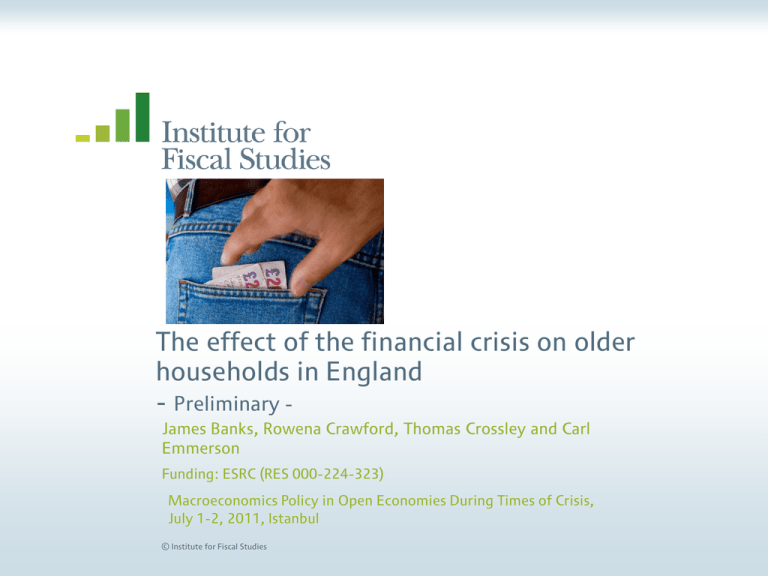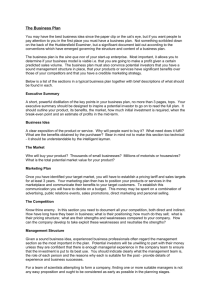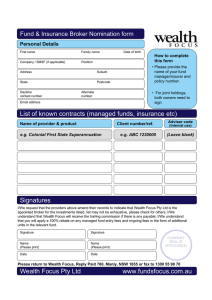The effect of the financial crisis on older households in England -
advertisement

The effect of the financial crisis on older households in England - Preliminary James Banks, Rowena Crawford, Thomas Crossley and Carl Emmerson Funding: ESRC (RES 000-224-323) Macroeconomics Policy in Open Economies During Times of Crisis, July 1-2, 2011, Istanbul © Institute for Fiscal Studies Introduction (1) • Recent financial crisis associated with large asset prices falls • In the UK in 2008–09 – FTSE All-Share Index fell by one-third – Nationwide House Price Index fell by one-fifth • Those close to retirement might have been relatively exposed: – high rates of home ownership and relatively large stocks of nonhousing wealth – little time to adjust behaviour before their planned retirement date • Those already retired will have annuitised much of their wealth • Those further from retirement have more time to adjust their subsequent behaviour © Institute for Fiscal Studies Introduction (2) • Overall Project: use English Longitudinal Survey of Ageing to examine 4 potential impacts of the financial crisis on those approaching and in retirement 1. scale and distribution of falls in wealth 2. plans and expectations for later life 3. Labour supply and consumption 4. health and well-being • Today: preliminary results on 1 and 2. © Institute for Fiscal Studies Introduction (3) • Estimates of interest in their own right – What happened? – Indication of how longer-run impacts of this crisis might play out • Also of interest in a broader context – builds on literature using economic shocks to estimate various effects (especially labour supply, health) – increases understanding of quantitative measures of economic expectations © Institute for Fiscal Studies Outline • UK crisis timeline and ELSA Data • Scale and distribution of financial losses • Effects on expectations – descriptive statistics • Effects on expectations – econometric estimates • Summary and future directions © Institute for Fiscal Studies October 08 Bank rescue packages & nationalisations Monthly FTSE All-Share index (April 2006=100) July 08-September 08 Fannie Mae/Freddie Mac 120 Autumn 08 Fiscal stimulations, including UK VAT cut. Large monetary stimulus via cuts to BoE base rate 100 80 13 September 07 Northern Rock 60 40 Spring 09 Large monetary stimulus via cuts to BoE base rate and QE April 07 Beginning of sub-prime collapse 15 September 08 Lehman Brothers 20 Apr/06 May/06 Jun/06 Jul/06 Aug/06 Sep/06 Oct/06 Nov/06 Dec/06 Jan/07 Feb/07 Mar/07 Apr/07 May/07 Jun/07 Jul/07 Aug/07 Sep/07 Oct/07 Nov/07 Dec/07 Jan/08 Feb/08 Mar/08 Apr/08 May/08 Jun/08 Jul/08 Aug/08 Sep/08 Oct/08 Nov/08 Dec/08 Jan/09 Feb/09 Mar/09 Apr/09 May/09 Jun/09 Jul/09 Aug/09 Sep/09 0 October 08 Bank rescue packages & nationalisations Monthly FTSE All-Share index (April 2006=100) July 08-September 08 Fannie Mae/Freddie Mac 120 ELSA wave 4 fieldwork ELSA wave 3 fieldwork Autumn 08 Fiscal stimulations, including UK VAT cut Large monetary stimulus via cuts to BoE base rate 100 80 13 September 07 Northern Rock 60 40 Spring 09 Large monetary stimulus via cuts to BoE base rate and QE April 07 Beginning of sub-prime collapse 15 September 08 Lehman Brothers 20 Apr/06 May/06 Jun/06 Jul/06 Aug/06 Sep/06 Oct/06 Nov/06 Dec/06 Jan/07 Feb/07 Mar/07 Apr/07 May/07 Jun/07 Jul/07 Aug/07 Sep/07 Oct/07 Nov/07 Dec/07 Jan/08 Feb/08 Mar/08 Apr/08 May/08 Jun/08 Jul/08 Aug/08 Sep/08 Oct/08 Nov/08 Dec/08 Jan/09 Feb/09 Mar/09 Apr/09 May/09 Jun/09 Jul/09 Aug/09 Sep/09 0 October 08 Bank rescue packages & nationalisations Monthly FTSE All-Share index (April 2006=100) July 08-September 08 Fannie Mae/Freddie Mac 120 ELSA wave 4 fieldwork ELSA wave 3 fieldwork Autumn 08 Fiscal stimulations, including UK VAT cut Large monetary stimulus via cuts to BoE base rate 100 80 13 September 07 Northern Rock 60 `After’ `During’ 20 15 September 08 Lehman Brothers `Before’ 40 Spring 09 Large monetary stimulus via cuts to BoE base rate and QE April 07 Beginning of sub-prime collapse Apr/06 May/06 Jun/06 Jul/06 Aug/06 Sep/06 Oct/06 Nov/06 Dec/06 Jan/07 Feb/07 Mar/07 Apr/07 May/07 Jun/07 Jul/07 Aug/07 Sep/07 Oct/07 Nov/07 Dec/07 Jan/08 Feb/08 Mar/08 Apr/08 May/08 Jun/08 Jul/08 Aug/08 Sep/08 Oct/08 Nov/08 Dec/08 Jan/09 Feb/09 Mar/09 Apr/09 May/09 Jun/09 Jul/09 Aug/09 Sep/09 0 Apr/06 May/06 Jun/06 Jul/06 Aug/06 Sep/06 Oct/06 Nov/06 Dec/06 Jan/07 Feb/07 Mar/07 Apr/07 May/07 Jun/07 Jul/07 Aug/07 Sep/07 Oct/07 Nov/07 Dec/07 Jan/08 Feb/08 Mar/08 Apr/08 May/08 Jun/08 Jul/08 Aug/08 Sep/08 Oct/08 Nov/08 Dec/08 Jan/09 Feb/09 Mar/09 Apr/09 May/09 Jun/09 Jul/09 Aug/09 Sep/09 Regional house price indices UK Land registry data (April 2006=100) 130 ELSA wave 3 fieldwork ELSA wave 4 fieldwork 120 110 100 90 80 70 English Longitudinal Study of Ageing • ~12,100 respondents aged 50+ in England in 2002–03 (wave 1) – respondents re-interviewed biennially – refreshment samples in 2006–07 (wave 3) and 2008–09 (wave 4) Distribution of interview timings: ELSA waves 3 and 4 W4: Before W4: During W4: After W4: All W3: Before 1,985 575 426 2,986 W3: During 986 967 1,242 3,195 6 303 828 1,137 2,977 1,845 2,496 7,318 W3: After W3: All © Institute for Fiscal Studies English Longitudinal Study of Ageing • Detailed information on economic situation and health – financial wealth, debt and housing at every wave – full pension details at every wave – Subjective and objective health (physical and mental) – quantitative measures of expectations of the future – subjective measures of wellbeing and financial situation © Institute for Fiscal Studies Pension wealth • Significant part of the project is the creation of measures of state and private pension wealth (now complete) • Pension income: – pensions in payment (private and state) use self-reported income – current DB: use self-reported pension tenure, salary and scheme rules – past DB: use self-reported pension tenure, impute final salary under assumption that earnings relative to median for sex/date-of-birth/education cohort constant over time, apply typical scheme rules dependent on sector of employment – current and past DC: take self-reported accrued fund value, accrue at 2% real rate of return to SPA, apply market annuity rates – state pensions: take self-reported employment, earnings history calculated as for past DB, and apply state pension rules • Pension wealth: – discounted PDV of these income streams to sex specific life expectancy (plus any survivor benefits) © Institute for Fiscal Studies Estimating exposure and effects • Exposure of wealth to financial crisis uses pre-crisis estimates of: – house values – risky financial asset holdings – ‘safe’ financial assets – mortgage and non-mortgage debt – pension wealth (private DB, private DC and state pension wealth) • Simulated gains or losses computed using monthly asset price indices and month of interview in both wave 3 and 4 • Actual gains or losses between wave 3 and 4 computed directly from the ELSA data © Institute for Fiscal Studies Simulated losses (cont’d) • Relevant asset price index: 1 (“Safe”) FTSE All-share Current accounts, savings accounts, cash ISAs, TESSAs Investment ISAs, premium bonds, national savings accounts, PEPs, shares, Trusts, Bonds and Gilts, physical wealth, current and retained DB pensions, pensions in receipt, state pensions Mortgages, debt © Institute for Fiscal Studies current and retained defined contribution pensions Regional house price Value of main home England average house price Value of second homes, other property wealth Exposure : Pre-Crisis Wealth Holdings (1) © Institute for Fiscal Studies Exposure: Pre-Crisis Wealth Holdings (2) © Institute for Fiscal Studies Distribution of index changes ELSA wave 3 to Wave 4 (2006–07 to 2008–09) Simulated wealth changes (1) ELSA wave 3 to wave 4 (2006–07 to 2008–09) Simulated wealth changes (2) ELSA wave 3 to wave 4 (after group) Simulated wealth changes (3) Peak to Trough (05/07 to 03/09) Simulated wealth changes (4) ELSA wave 3 to wave 4 (2006–07 to 2008–09) © Institute for Fiscal Studies Simulated wealth changes (5) Peak to Trough © Institute for Fiscal Studies Actual Wealth Changes (1) ELSA wave 3 to wave 4 (2006–07 to 2008–09) Actual Wealth Changes (3) ELSA wave 3 to wave 4 (2006–07 to 2008–09) © Institute for Fiscal Studies Measuring subjective expectations in ELSA “Now I have some questions about how likely you think various events might be. When I ask a question I'd like you to give me a number from 0 to 100, where 0 means that you think there is absolutely no chance an event will happen, and 100 means that you think the event is absolutely certain to happen.” “Let’s try an example and start with the weather. What do you think the chances are that it will be rainy tomorrow?” Expectations measures in ELSA waves 1-4 Chances of living to 75 or more (80,85,90…) 02 04 06 08 Move out of current house Move into nursing home in next five years Being in paid work at 55/60 (60/65) Health limit ability to work before 65 Not enough financial resources to meet future needs Leave bequest (>50,000; >0; >150,000) Receive inheritance (>0; >10,000; >100,000) House price change (<-10%, <-5%, >5%, >10%) Total public pension income on retirement () Total private pension income on retirement () Expectations (1) Expectations (2) © Institute for Fiscal Studies Expectations (3) © Institute for Fiscal Studies Estimating Wealth Effects(1/2) • Basic specification: ∆Ow4 = α + β∆Ww4 + u • But change in wealth between wave 3 and wave 4 endogenous? – individuals might save more to compensate for financial crisis losses – also measurement errorr • Use predicted change in wealth between wave 3 and wave 4 as an instrument? – assumes: level and composition of wave 3 wealth, date of interview and region is random with respect to the change in outcome – measurement error in wave 3 wealth would invalidate this instrument • Instead we construct an instrument combining wave 2 wealth and the change in index values between wave 2 and wave 4 interviews – assumes wave 2 measurement error uncorrelated with that in wave 3,4 © Institute for Fiscal Studies Econometric Methods (2/2) • Models run for across all individuals – separate models for those aged under 70 and those aged 70 and over to allow for different wealth effects by age • Alternative specification allowing for separate impact of different wealth types (net housing, pension, other): – predicted change in wealth types used as instruments for observed changes, again using wave 2 wealth to construct the instruments • IV-Linear, IV-Interval Regression and IV-Ordered Probit – Marginal effects for IV-linear and IV-interval regression • Minimum Detectable Effects • Note: raw dependent variables [-100,100] © Institute for Fiscal Studies Results (1) © Institute for Fiscal Studies Results (2) © Institute for Fiscal Studies Results (3) © Institute for Fiscal Studies Results (4) © Institute for Fiscal Studies Minimum Detectable Effects © Institute for Fiscal Studies Main findings (1/2) • Pre-crisis portfolios suggest that the crisis will have significantly reduced the wealth of many – Simulations suggest almost 10% lost more than 10% of their total wealth W3 to W4; 20% of the “after” group lost more than 10% of total wealth. – Simulations suggest 40% lost more than 10% of their total wealth peak to trough. • Actual wealth changes W3 to W4 more disperse than simulations – Behaviour (eg. active saving), return heterogeneity, measurement error • As the crisis unfolded aggregate trends in reported chances of future events: – Small reduction in in chance of leaving bequests greater than ₤150K – Small increase in chance of not having adequate resources © Institute for Fiscal Studies Main findings (2/2) • Small impacts of wealth on expectations: – wealth increases boost chances of expecting to leave a large bequest, • Primarily housing wealth • larger point estimates found for those 70 and over than those aged under 70 – wealth increases may reduce chances of expecting not to have adequate resources • Only for under 70s, primarily pension wealth • Only statistically significant in some specifications – Effects are small but precisely estimated (MDEs). © Institute for Fiscal Studies Further Work • Further analysis of effects on expectations and plans for later life • Consumption and labour supply • Health and wellbeing outcomes outcomes: – Focus on psychosocial health measures and on “high frequency” physical health measures (sleep, blood pressure). • Hypothesized link from income/wealth to neuroendocrine and cortisol responses which are risk factors for subsequent health (particularly cardiovascular health) • Prior evidence on wealth effects on health is mixed but passed studies have largely relied on small shocks and focussed on “endpoint” health measures – General wellbeing and quality of life © Institute for Fiscal Studies Extra Slides © Institute for Fiscal Studies 140 0 Apr-06 May-06 Jun-06 Jul-06 Aug-06 Sep-06 Oct-06 Nov-06 Dec-06 Jan-07 Feb-07 Mar-07 Apr-07 May-07 Jun-07 Jul-07 Aug-07 Sep-07 Oct-07 Nov-07 Dec-07 Jan-08 Feb-08 Mar-08 Apr-08 May-08 Jun-08 Jul-08 Aug-08 Sep-08 Oct-08 Nov-08 Dec-08 Jan-09 Feb-09 Mar-09 Apr-09 May-09 Jun-09 Jul-09 Aug-09 Sep-09 Consumer sentiment indices Nationwide consumer confidence survey (April 2006=100) ELSA wave 3 fieldwork Consumer confidence ELSA wave 4 fieldwork 120 100 80 60 40 20 Present situation Expectations Simulated wealth changes (6) ELSA wave 3 to wave 4 (2006–07 to 2008–09) © Institute for Fiscal Studies Actual Wealth Changes (4) ELSA wave 3 to wave 4 (2006–07 to 2008–09) © Institute for Fiscal Studies Actual Wealth Changes (2) ELSA wave 3 to wave 4 (after group)







